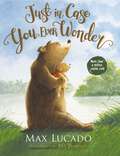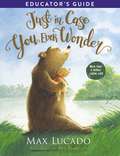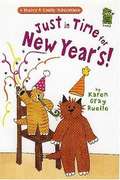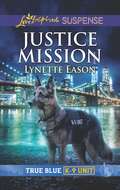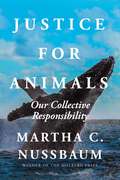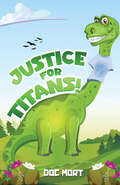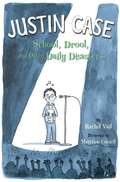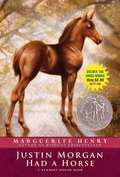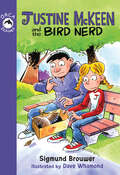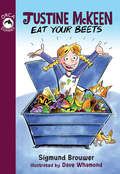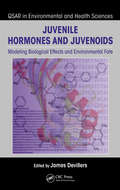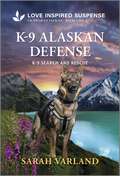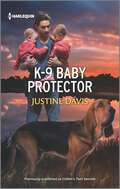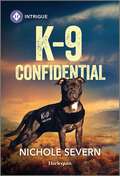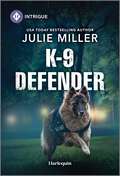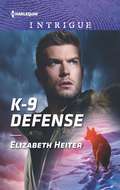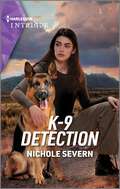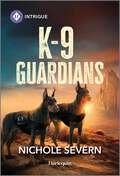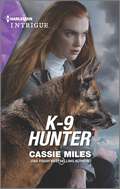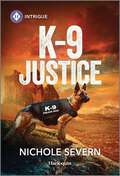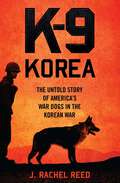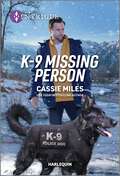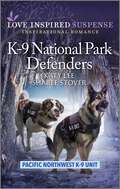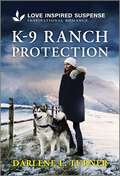- Table View
- List View
Just in Case You Ever Wonder (Just in Case)
by Max LucadoThis book assures children of God's love through all their experiences—including during hard times such as being afraid of the dark or being bullied—and gives assurance that their parent was there when they were first born and will be with them even in heaven.From New York Times bestselling author Max Lucado comes Just in Case You Ever Wonder, the classic children&’s book that has made its way into hearts and story times around the world. Whether you have treasured this book for years or are reading it for the first time with your little ones, this timeless reminder of the love between a parent and a child—and ultimately, between God the Father and us—will come to hold a special place in your heart and home.This award-winning picture bookhas sold 1.7 million copies, touching lives for more than 25 years;now includes new, breathtaking art from Eve Tharlet of a loving parent and baby bear; andreminds children of Jesus&’ unconditional love.Just in Case You Ever Wonder isperfect for children ages 3–7;an introduction to God&’s great love; anda great present for Christmas, other gift-giving holidays, or celebrations.Children long to hear they&’re special and loved. Just in Case You Ever Wonder assures them that as they grow and change, in both good and bad times, you—and their heavenly Father—will always be on their side . . . just in case they ever wonder.
Just in Case You Ever Wonder Educator's Guide (Just in Case)
by Max LucadoJust in Case You Ever Wonder Educator's Guide is a companion to Just in Case You Ever Wonder by Max Lucado. This guide can be utilized in the classroom, in a home school setting, or by parents seeking additional resources. Ideal for 1st graders.
Just in Time for New Year's! (A Harry & Emily Adventure)
by Karen Gray RuelleYippee! It's almost New Year's Eve. On the big night, kittens Harry and Emily are going to stay up until midnight. But how will they stay awake?
Justice Mission: Justice Mission Identity: Classified Undercover Jeopardy (True Blue K-9 Unit #3)
by Lynette EasonCaught in a killer’s sights…Introducing the True Blue K-9 Unit seriesAfter K-9 unit administrative assistant Sophie Walters spots a suspicious stranger lurking at the K-9 graduation, the man kidnaps her—and she barely escapes. With Sophie’s boss missing and someone determined to silence her, NYPD officer Luke Hathaway vows he and his K-9 partner will guard her. But he must keep an emotional distance to ensure this mission ends in justice…not cold-blooded murder.
Justice for Animals: Our Collective Responsibility
by Martha C. NussbaumA revolutionary new theory and call to action on animal rights, ethics, and law from the renowned philosopher Martha C. Nussbaum.Animals are in trouble all over the world. Whether through the cruelties of the factory meat industry, poaching and game hunting, habitat destruction, or neglect of the companion animals that people purport to love, animals suffer injustice and horrors at our hands every day. The world needs an ethical awakening, a consciousness-raising movement of international proportions. In Justice for Animals, one of the world&’s most influential philosophers and humanists Martha C. Nussbaum provides a revolutionary approach to animal rights, ethics, and law. From dolphins to crows, elephants to octopuses, Nussbaum examines the entire animal kingdom, showcasing the lives of animals with wonder, awe, and compassion to understand how we can create a world in which human beings are truly friends of animals, not exploiters or users. All animals should have a shot at flourishing in their own way. Humans have a collective duty to face and solve animal harm. An urgent call to action and a manual for change, Nussbaum&’s groundbreaking theory directs politics and law to help us meet our ethical responsibilities as no book has done before.
Justice for Titans!
by Doc MortEven if it wanted to, what could the world’s largest ever creature do to help two very much smaller people in a crisis? Find out, as two girls visit their friend at a private school for boys to find out what it’s like. Invited to an Open Day as the school wants to open its doors to girls for the first time, they get caught up in an unfamiliar world and what they find surprises and shocks them. When they try to find solutions, they just get themselves into trouble. How do they deal with it and what happens to them? Justice for Titans! is an adventure placed in an ‘old school’ setting. It shows what can happen when different worlds collide but there’s always plenty of fun!
Justin Case: School, Drool, And Other Daily Disasters
by Rachel Vail Matthew CordellIt's the start of the school year, and nothing feels right to Justin. He didn't get the teacher he wanted, he's not in the same class as his best friend, and his little sister, Elizabeth, is starting kindergarten at his school. Elizabeth doesn't seem nervous at all. Justin is very nervous about third grade. And to top it off, he's lost his favorite stuffed animal, but he can't tell anyone, because technically he's too old to still have stuffed animals. Right? Here is third grade in all its complicated glory--the friendships, the fears, and the advanced math. Acclaimed author Rachel Vail captures third grade with a perfect pitch, and Matthew Cordell's line art is both humorous and touching. As Justin bravely tries to step out of his shell, he will step into readers' hearts.
Justin Morgan Had a Horse
by Marguerite HenryJoel Goss knows that Little Bub is a special colt, even though he's a runt. And when schoolteacher Justin Morgan asks Joel to break the colt in, Joel is thrilled! Soon word about Little Bub has spread throughout the entire Northeast--this spirited colt can pull heavier loads than a pair of oxen. And run faster than thoroughbreds! This is the story of the little runt who became the father of the world-famous breed of American horses--the Morgan.<P><P> Newbery Medal Honors book.
Justin Morgan Had a Horse
by Marguerite Henry Wesley DennisJoel Goss knows that Little Bub is a special colt, even though he's a runt. And when schoolteacher Justin Morgan asks Joel to break the colt in, Joel is thrilled! Soon word about Little Bub has spread throughout the entire Northeast--this spirited colt can pull heavier loads than a pair of oxen. And run faster than thoroughbreds! This is the story of the little runt who became the father of the world-famous breed of American horses--the Morgan.
Justine McKeen and the Bird Nerd (Orca Echoes)
by Sigmund BrouwerMeet Justine McKeen, the Queen of Green. She's trying to save the planet, one person at a time, and when she decides to get something done, it's a lot of fun. When a small bird is injured after flying into a school window, the students are shocked and upset. But they are even more shocked when school bully Jimmy Blatzo rescues the bird and nurses it back to health. Blatzo may have saved one bird, but the problem is much bigger and not confined to the school grounds. Birds are flying into the windows at the town hall too. With the help of Justine, green activist extraordinaire, Blatzo gets the courage he needs to approach town council. Getting over his fear of public speaking will be one challenge. Getting used to his new nickname, Bird Nerd, will be another matter entirely. The epub edition of this title is fully accessible.
Justine McKeen, Eat Your Beets (Orca Echoes)
by Sigmund Brouwer Dave WhamondMeet Justine McKeen, the Queen of Green. She talks a little too much, bosses a little too much and tells the truth, just not all at once. She's trying to save the planet, one person at a time, and when she decides to get something done, it's a lot of fun. In Justine McKeen, Eat Your Beets, the fourth book in the Justine McKeen series, Justine has another brilliant idea to help the planet. When she learns a stray cat and her kittens are living off the food in their school Dumpster, Justine sets out to reduce waste and help save animals in need. Her friends are supportive, but convincing grumpy Mr. Raymond, the cafeteria's manager, to help them put Justine's plan in action is another matter altogether.
Juvenile Hormones and Juvenoids: Modeling Biological Effects and Environmental Fate (QSAR in Environmental and Health Sciences)
by James DevillersJuvenile hormones (JHs) are a group of structurally related sesquiterpenes secreted by the insect corpora allata. They affect most insect life-cycle stages and physiological functions, including embryogenesis, larval and adult development, metamorphosis, reproduction, metabolism, diapause, polyethism, and migration. Juvenoids such as methoprene, hy
K-9 Alaskan Defense (K-9 Search and Rescue)
by Sarah VarlandA K-9 stands guard… while a killer closes in. Discovering a dead body in the woods turns into a fight for survival when Lily Peterson is attacked by an unknown assailant. Rescued by her retired police K-9, Timber, Lily calls the one man she trusts for help—her late fiancé&’s partner, former officer Travis Beckett. Only, the danger proves to be far from over when Lily&’s house goes up in flames. Someone wants her dead, and all clues lead to a connection to her departed fiancé&’s final case. Investigating the past is the only way to stay alive…but can they elude a killer neither expects?From Love Inspired Suspense: Courage. Danger. Faith.K-9 Search and Rescue Book 1: Desert Rescue by Lisa PhillipsBook 2: Trailing a Killer by Carol J. PostBook 3: Mountain Survival by Christy BarrittBook 4: Search and Defend by Heather WoodhavenBook 5: Following the Trail by Lynette EasonBook 6: Dangerous Mountain Rescue by Christy BarrittBook 7: Wilderness Hunt by Lisa PhillipsBook 8: Alaskan Mountain Search by Sarah VarlandBook 9: Alaskan Avalanche Escape by Darlene L. TurnerBook 10: Tracking Stolen Treasures by Lisa PhillipsBook 11: Alaskan Wilderness Rescue by Sarah VarlandBook 12: Lethal Mountain Pursuit by Christy BarrittBook 13: Tracking the Missing by Sami A. AbramsBook 14: K-9 Alaskan Defense by Sarah VarlandBook 15: Searching for Justice by Connie Queen
K-9 Baby Protector
by Justine DavisA K-9 cop's new family comes under fire Officer Dante Mancuso pursues justice with only the company of his K-9 partner. But when tragedy strikes, the bewildered bachelor winds up with custody of his infant nieces. Desperate for help, Dante hires heiress Gemma Colton to help him care for the little girls. As they grow closer caring for the babies, shadows from their respective pasts threaten their growing bond.Previously published as Colton's Twin Secrets
K-9 Confidential (New Mexico Guard Dogs)
by Nichole SevernThis fierce K-9Is facing killer oddsSecurity agent Granger Morais is stunned when he and his K-9, Zeus, confront the one person he thought was dead—and can&’t afford to trust again. Helping ex-informant Charlie Acker discover who killed her young sister may be key to taking down her powerful extremist family. But when Granger must protect her from a ruthless cartel that wants her special skills, will his and Charlie&’s troubled history—and reignited heat—keep them alive…or be the one trap they never saw coming?From Harlequin Intrigue: Seek thrills. Solve crimes. Justice served.Discover more action-packed stories in the New Mexico Guard Dogs series. All books are stand-alone with uplifting endings but were published in the following order: Book 1: K-9 SecurityBook 2: K-9 DetectionBook 3: K-9 ShieldBook 4: K-9 GuardiansBook 5: K-9 ConfidentialBook 6: K-9 Justice
K-9 Defender (Protectors at K-9 Ranch #2)
by Julie MillerCan one woman's K-9 Convince her to trust a determined detective? After a betrayal that almost took his life, Detective Joel Standage is deskbound. A new assignment is his chance to find out if he still has what it takes to be a cop. His mission? Get close to Mollie Crane, a woman who&’s as guarded—and wounded—as he is. Her service dog, Magnus, trusts Joel before she does. When it becomes clear that his interest in her crime boss ex-husband is putting her in danger, what started as a case becomes personal, and Joel will do whatever it takes to protect her…From Harlequin Intrigue: Seek thrills. Solve crimes. Justice served.Discover more action-packed stories in the Protectors at K-9 Ranch series. All books are stand-alone with uplifting endings but were published in the following order: Book 1: Shadow SurvivorsBook 2: K-9 DefenderBook 3: Special Forces K-9Book 4: Protecting the Pack
K-9 Defense
by Elizabeth HeiterTo help a desperate woman’s search,he’ll have to brave treacherous territory.In the wilds of Alaska, grieving former marine Colter Hayes shuts out the world…until he and his combat tracker dog become Kensie Morgan’s last hope of finding her long-missing sister. The improbable mission starts to rekindle Colter’s desire to rejoin the world—while saving Kensie from a killer unsettles his heart. Can they find all they are searching for before it’s too late?
K-9 Detection (New Mexico Guard Dogs #2)
by Nichole SevernThey survived an explosion.Can they make it through the aftermath? After her bomb-detecting K-9 helps Jocelyn Carville save Captain Baker Halsey&’s life, she doesn&’t expect them to be working together on the investigation. The policeman clearly doesn&’t trust widowed Jocelyn&’s &“mercenary&” background but he does need her company&’s expertise. Infiltrating a powerful cartel to discover who wants him dead is intensely dangerous. Perhaps just as risky as getting close to a woman like Jocelyn…From Harlequin Intrigue: Seek thrills. Solve crimes. Justice served.Discover more action-packed stories in the New Mexico Guard Dogs series. All books are stand-alone with uplifting endings but were published in the following order: Book 1: K-9 SecurityBook 2: K-9 DetectionBook 3: K-9 Shield
K-9 Guardians (New Mexico Guard Dogs)
by Nichole SevernA violent cartel&’s bloody reign of terror must be stoppedBut these K-9s and their partners don&’t scare easily When King Elsher&’s murdered partner falls in Scarlett Beam&’s path—literally—the DEA agent and security expert find themselves in a deadly cartel&’s crosshairs. The message is clear: stop interfering with their business or they&’ll be the next victims. The past taught King to keep professional and personal separate. But Scarlett&’s wit and determination tempt him to break his code. And then his son is kidnapped, raising the stakes even further. One wrong step can get them killed. Can King get justice…and keep them all alive?From Harlequin Intrigue: Seek thrills. Solve crimes. Justice served.Discover more action-packed stories in the New Mexico Guard Dogs series. All books are stand-alone with uplifting endings but were published in the following order: Book 1: K-9 SecurityBook 2: K-9 DetectionBook 3: K-9 ShieldBook 4: K-9 GuardiansBook 5: K-9 ConfidentialBook 6: K-9 Justice
K-9 Hunter
by Cassie MilesWhen unspeakable danger strikes close to home, She&’ll risk everything for justice.Piper Comstock and her dog, Izzy, live a peaceful life in the Oregon forest. Until her best friend and his daughter are targeted by an assassin. US Marshal Gavin McQueen knows the truth—a witness in protection has been compromised. Now a gang kingpin wants revenge. Piper vows to help Gavin catch the culprit. But as the danger—and duo—grows closer, is the peril to Piper&’s life…or to her heart?From Harlequin Intrigue: Seek thrills. Solve crimes. Justice served.Discover more action-packed stories in theseries. All books are stand-alone with uplifting endings but were published in the following order:
K-9 Justice (New Mexico Guard Dogs)
by Nichole SevernA K-9 will help her catch a criminal cartel Socorro Security founder Ivy Bardot had dedicated the last two years to taking down a cartel. She&’d even sent in her former FBI partner, Carson Lang, as an undercover operative. Now the syndicate was coming for members of her team. Despite having her trusted K-9, Ivy also needed Carson out and by her side. But revealing his true identity could come with a dire price. They&’d sacrificed so much, including their own feelings, to seek justice. Were they prepared to risk their own lives?From Harlequin Intrigue: Seek thrills. Solve crimes. Justice served.Discover more action-packed stories in the New Mexico Guard Dogs series. All books are stand-alone with uplifting endings but were published in the following order: Book 1: K-9 SecurityBook 2: K-9 DetectionBook 3: K-9 ShieldBook 4: K-9 GuardiansBook 5: K-9 ConfidentialBook 6: K-9 Justice
K-9 Korea: The Untold Story of America's War Dogs in the Korean War
by J. Rachel ReedThe men of the 8125th Sentry Dog Detachment had no idea what they would find when their ship docked at Incheon, Korea. The dogs in the unit seemed even more uncertain than the men: they could smell the terror in the place. Almost immediately, these soldiers came to rely on each other—man and dog alike—for safety, courage, and companionship.Yet in the end, the men of the 8125th could have never imagined the terrible and final sacrifice their canine companions would be forced to make. K-9 Korea is the heartrending story of American war dogs—the fearless, loyal, forgotten heroes of the Korean War.
K-9 Missing Person
by Cassie MilesA detective and his dog have survived it allBut his latest case puts them to the ultimate test. Private investigator Shane Reilly and his trusty K-9 sidekick, Elvis, are legendary at solving crimes. But taking on Mallory Greenfield&’s missing mother case is their toughest job yet. Between a faked death, a legendary diamond and a surprise sister, Mallory needs their protection. But when the bullets fly and the danger closes in, will Shane and Elvis save the woman who captured their hearts?From Harlequin Intrigue: Seek thrills. Solve crimes. Justice served.
K-9 National Park Defenders (Pacific Northwest K-9 Unit)
by Katy Lee Sharee StoverPeril at Christmas awaits… in these gripping Pacific Northwest K-9 Unit novellas A Christmas skiing retreat turns treacherous when Pacific Northwest K-9 Unit officer Veronica Eastwood&’s sister is kidnapped—and only rival officer Parker Walsh can help her in Katy Lee&’s Yuletide Ransom. And in Sharee Stover&’s explosive Holiday Rescue Countdown, K-9 officers Dylan Jeong and Brandie Weller must race against the clock when they face a Christmas parade bomb threat…and a killer from Dylan&’s past.From Love Inspired Suspense: Courage. Danger. Faith.Pacific Northwest K-9 Unit Book 1: Shielding the Baby by Laura ScottBook 2: Scent of Truth by Valerie HansenBook 3: Explosive Trail by Terri ReedBook 4: Olympic Mountain Pursuit by Jodie BaileyBook 5: Threat Detection by Sharon DunnBook 6: Cold Case Revenge by Jessica R. PatchBook 7: Undercover Operation by Maggie K. BlackBook 8: Snowbound Escape by Dana Mentink
K-9 Ranch Protection (Crisis Rescue Team #6)
by Darlene L. TurnerA killer on the loose. A K-9 keeping watch. Police constable Izzy Tremblay knows her father&’s death was no accident, so when she finally discovers a lead and is immediately attacked, her suspicions are confirmed. The ambush leaves her in the hospital with three hours of crucial memory missing, which she knows holds the key to finding her father&’s murderer. For protection, she takes refuge with her ex-partner, Austin Murray, on his K-9 ranch while she races to uncover the truth. But with danger still lurking, can they stay alive long enough to take down a killer?From Love Inspired Suspense: Courage. Danger. Faith.Crisis Rescue Team Book 1: Fatal Forensic InvestigationBook 2: Explosive Christmas ShowdownBook 3: Mountain Abduction RescueBook 4: Buried Grave SecretsBook 5: Yukon Wilderness EvidenceBook 6: K-9 Ranch Protection
